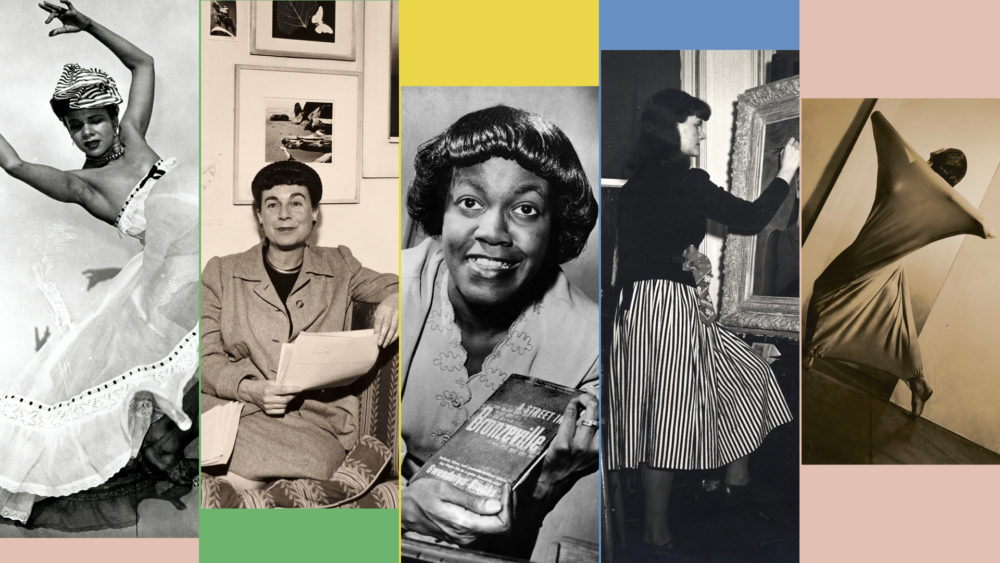Set in the decades between 1930 and 1960, Liesl Olson’s Chicago Avant-Garde: Five Women Ahead of Their Time shows us how five women—painter Gertrude Abercrombie, poet Gwendolyn Brooks, choreographers Katherine Dunham and Ruth Page, and curator Katharine Kuh—championed “the radical, experimental culture that emerged in Chicago across a range of artistic disciplines in the first half of the 20th century.”
The book, a catalog to accompany the exhibit of the same name, which closed at the Newberry Library in December, demonstrates how these women significantly influenced poetry, dance, and visual art during the Great Depression, racialized violence, World War II, and the emergence of the Red scare, all before the major social and political transformations of the 1960s. Chicago writer, scholar, and cultural organizer Eve Ewing joins Olson in highlighting their lives and legacies through five poems, one dedicated to each woman and pivotal moments in their lives.
In the book, Olson moves through the interconnected life experiences of each of these women, starting with Surrealist artist Abercrombie (1909-1977). Mainly a self-taught painter, Abercrombie was well-known for her commitment to Chicago and a specific Midwesterness in her paintings, often in combination with a sort of fantastical otherworldliness. Living in Hyde Park from 1916 until her passing, Abercrombie was known by many as the “queen of the bohemian artists” and regularly hosted an arts salon open to queer and interracial audiences in an era where segregation remained the norm.
Abercrombie also lived not too far from Olson’s second key figure: Brooks (1917-2000). Possibly the most famous woman in the collection, Brooks was one of the twentieth century’s most influential poets and the first Black person to ever win the Pulitzer Prize for Poetry. She was also deeply engaged in her local community, largely writing her debut collection of poetry, A Street in Bronzeville, in workshops at the South Side Community Art Center. She later became a major figure in the Black Arts Movement of the 1960s and also taught and mentored youth at Chicago State University, which ultimately founded the Gwendolyn Brooks Center for Black Literature and Creative Writing, located at 95th and South King Drive, in her honor.
While Abercrombie and Brooks focused primarily on painting and poetry, two of Chicago Avant Garde’s featured women centered dance in their work. The first of the two, Dunham (1909-2006), was called the “Matriarch of Black Dance” and started out as an anthropologist. With her academic training, she initially studied the intersection of Caribbean-based African dance practices and the continuance of those creative forms in Chicago.
Shifting to a career in dance, Dunham ultimately drew from her studies to create her own “Dunham Technique”, which continues to be taught amongst her students. Her counterpart, Page (1899-1991), also followed an international career, starting out as a ballerina who traveled widely for her work. In Chicago, she was known as one of the first dancers to perform in an integrated ballet and later ended up founding the Ruth Page Center for the Arts in 1971 located just behind the Newberry Library.
Olson lastly introduces Kuh (1904-1994), a gallerist, curator, and critic who worked as the first curator of Modern painting and sculpture at the Art Institute of Chicago. Prior to her work at the Art Institute, she also opened and ran her own Chicago-based gallery space, showing innovative and controversial arts pieces from both local artists and those from abroad. Like the others, Kuh experienced a great deal of pushback to her endeavors: one of Ewing’s poems recounts that the windows of her gallery were smashed, likely in protest of the non-traditional artistic work that she supported at her gallery.
In recognizing these five women’s achievements, Olson accounts for the ways that racialized norms and policies shaped their experiences in the city differently. For instance, Olson shows how Kuh, Page, and Abercrombie, all white women, were able to maintain connections to elite cultural spaces across the city of Chicago, whereas Brooks and Dunham, both Black women, experienced discriminatory exclusion from various Chicago arts organizations, especially those on the North Side.
In response, Olson also highlights how Brooks and Dunham oriented their careers towards building and supporting spaces for Black artists, both in and beyond Chicago. In moving through the complexities of their lives, particularly during this historical era, Olson ultimately works to show how “by choice and necessity, these women navigate outside of traditional forms of female legacy” and were able to “build things up as much as they tore things down.” Olson makes known to us how the women, whose efforts often go unrecognized in canonical histories of arts and culture, brought “freedom and expansion in an era marked by discrimination and social division.”
Finally, by focusing on Chicago, Olson lingered on the uniqueness of the city in fueling these women’s unanticipated social experimentation and change. To Olson, unlike the “rarified art worlds of New York and Paris, the Chicago art world operated differently…independent, unfettered,” and these five women “crossed boundaries, built institutions, and supported one another in Chicago and well beyond.”
Their legacies continue to shape the contemporary Chicago cultural world, with artists such as Vershawn Sanders-Ward, the artistic director and CEO of 63 Street’s Red Clay Dance Company, continuing to teach the Dunham Technique to their students. Lastly, Olson added that many others maintain this legacy of radical social change, with artists like Ewing continuing to work at the intersections of art and activism in a way that recognizes the limitations of the now and also holds to imagining beyond it.
For those interested in learning more about Chicago Avant-Garde, the Newberry Library also created this video tour of the book’s previous exhibit at the library.
Lauren Beard is a PhD Student in the Department of Sociology at the University of Chicago. This is her first story for the Weekly.


What a terrific story! Thank you for your work Dr. Beard!